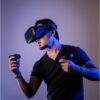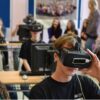Documentation

“Using Slide Shows Asks for Reconsideration” – Justyna Jakubiec
Trying to imagine studying and working without slide shows in the background might prove to turn into a highly challenging quest. That is especially valid nowadays, considering the ongoing pandemic that makes quite a significant number of people stay in their homes. Perhaps that certainty and obviousness characterizing our approach to slide shows somehow overshadow…
Read more
“Configurations of Vision, Technology, and Knowledge: What Comes Next?” – Eleonora Stacchiotti
During the last session of Transmission in Motion’s series of seminars, Professor Frank Kessler and researchers Jamilla Notebaard and Nico de Klerk introduced us to their work, which takes into consideration and analyzes ways to divulgate knowledge through different technological apparatuses. Kessler focused on the semiotic structure through which works of art are encountered by…
Read more
“Human-Technology Assemblages” – Anthony Nestel
In her article “Next Slide Please: The Magical, Scientific, and Corporate Discourses of Visual Projection Technologies” (2006) Jennifer F. Eisenhauer strips technological entities from a pre-determined, fixed meaning. According to Eisenhauer, “technology acquires meaning through a complex series of relations” (Eisenhauer 2006, 198-199). By means of a genealogy of slide projection technologies, Eisenhauer eloquently demonstrates…
Read more
“Disciplining Perception Through Technology” – Hannah Harder
Jennifer Eisenhauer’s work “Next Slide Please: The Magical, Scientific, and Corporate Discourses of Visual Projection Technologies” (2006) shows how material technology takes on meaning through complex relationships. We can see how discourse changes in historic and cultural contexts such as with the magic or scientific lantern. What interests me is the way that vision seems…
Read more
“Making a Scene” – Bernice Ong
Having attended the seminar ‘Knowledge Transmission with the Lantern’ by Frank Kessler, Jamilla Notebaard and Nico de Klerk (24 Feb 2021), I note that with the advent of projection tools such as the optic lantern and photographic slides, there arose critical shifts not just in terms of how knowledge was transmitted, but indeed, how the…
Read more
“Magic Lanterns, PowerPoints and Dual Coding” – Floor Mijland
It almost sounds like an item from a children’s book: ‘The Magic Lantern’. It evokes images of far off places, daring sword fights and magic carpet rides. In a way, these mental images are not far off. When listening to Frank Kessler, Jamilla Notebaard and Nico de Klerk in the Transmission in Motion seminar of…
Read more
“The Objectivity and Interactivity in New Media Pedagogy” – Liang Yue
Whenever a new communicative technology is invented, researchers and businesses are arguing its value in didactics. This is not only because media have long been playing an educational role in the history of civilization, but also because new media’s affordances are in line with the enthusiasm of the educational revolution in terms of further objectivity…
Read more
“Reflections on the Center of Human-Centered Design” – Danny Steur
Artists make art, designers make everything else – or so Jon McKenzie announces, somewhat polemically, while discussing the Design Thinking central to his Transmedia Knowledge for Liberal Arts and Community Engagement (2019). This transmedial design practice, he writes, is “a method of human-centered design developed to tackle complex problems found in social and organizational contexts”…
Read more
“A Different Look at Design Justice” – Polyniki Katrantsioti
After the last Transmission in Motion seminar, I felt inspired in thinking about the ways in which a digital community can offer back to the people that have been wronged, have had their rights violated, misunderstood, and eventually hurt by the media and the way they are portrayed. In a completely different case, the life…
Read more
“True Interdisciplinarity” – Elena Roznovan
While the buzz word ‘interdisciplinary’ is used by many university programs today, what does interdisciplinarity really mean and what does it entail? If looked at closely the divisions amongst different fields of study within universities is still very prominent. Humanities to this day orient their methodologies of teaching and classroom proceedings in a seminar style….
Read more
